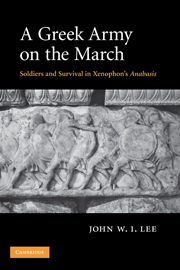Book contents
- Frontmatter
- Contents
- List of illustrations
- List of tables
- Preface
- Acknowledgments
- Abbreviations, transliterations, and other conventions
- Chapter 1 Introduction
- Chapter 2 The march route
- Chapter 3 The army
- Chapter 4 Unit organization and community
- Chapter 5 The things they carried
- Chapter 6 Marching
- Chapter 7 Resting
- Chapter 8 Eating and drinking
- Chapter 9 The soldier's body
- Chapter 10 Slaves, servants, and companions
- Chapter 11 Beyond the battlefield
- Tables
- Bibliography
- Index
Chapter 4 - Unit organization and community
Published online by Cambridge University Press: 22 September 2009
- Frontmatter
- Contents
- List of illustrations
- List of tables
- Preface
- Acknowledgments
- Abbreviations, transliterations, and other conventions
- Chapter 1 Introduction
- Chapter 2 The march route
- Chapter 3 The army
- Chapter 4 Unit organization and community
- Chapter 5 The things they carried
- Chapter 6 Marching
- Chapter 7 Resting
- Chapter 8 Eating and drinking
- Chapter 9 The soldier's body
- Chapter 10 Slaves, servants, and companions
- Chapter 11 Beyond the battlefield
- Tables
- Bibliography
- Index
Summary
For most of the mercenaries most of the time, the communities that counted were far smaller than the army assembly, almost 13,000 strong at its acme. They were smaller even than the various contingents of a thousand or more men apiece, although as we have seen contingent loyalties had their place in the life of the army. Instead, the communities that most mattered to the soldiers were those they interacted with on a constant and intimate basis, day in and day out for the nearly two years of the campaign. One of these communities, the lochos, was a formal tactical and administrative unit, mustering roughly 100 men. The other, the suskenia, was an informal small group, numbering perhaps ten or fifteen comrades at most.
FORMAL STRUCTURE: THE LOCHOS
The lochos, or “company,” was a common building block of many classical Greek citizen armies. The Argives, Boeotians, Corinthians, and Megarians, for example, all mustered hoplites in lochoi. The Athenians too had lochoi, an unknown number of which comprised each of their ten tribal regiments. In hoplite militia forces, lochoi were probably temporary groupings of varying strength rather than permanently defined units. At Athens, for example, the size of each tribal regiment and its component lochoi seems to have depended on the manpower needs of any given expedition, and hoplites might not always take the field in the same lochos.
- Type
- Chapter
- Information
- A Greek Army on the MarchSoldiers and Survival in Xenophon's Anabasis, pp. 80 - 108Publisher: Cambridge University PressPrint publication year: 2008



